2023.08.03.49
Files > Volume 8 > Vol 8 No 3 2023
Effect of milk protein coating and Nisin on the postharvest quality of strawberries (Fragaria ananassa).
Gina Guapi Álava1 , Vicente Guerrón Troya2
, Vicente Guerrón Troya2 , Tannia Oña Cundulle3
, Tannia Oña Cundulle3 , Karol Revilla Escobar3,4
, Karol Revilla Escobar3,4 , Jhonnatan Aldas Morejon3,5*
, Jhonnatan Aldas Morejon3,5* , Edgar Caicedo Álvarez6
, Edgar Caicedo Álvarez6
1 Universidad Técnica Estatal de Quevedo, Facultad de Ciencias de la Industria y Producción, [email protected],
2 Universidad Técnica Estatal de Quevedo, Facultad de Ciencias de la Industria y Producción, [email protected],
3 Universidad Laica Eloy Alfaro de Manabí, Facultad de Ciencia de la Vida y Tecnológicas, [email protected],
4 Universidad Técnica Estatal de Quevedo, Facultad de Ciencias de la Industria y Producción,
5 Universidad Técnica Estatal de Quevedo, Facultad de Ciencias de la Industria y Producción, [email protected],
6 Universidad Estatal del Sur de Manabí, Facultad de Ciencias Naturales y de la Agricultura, Carrera de Ingeniería Forestal, [email protected],
Available from: http://dx.doi.org/10.21931/RB/2023.08.03.49
ABSTRACT
Due to postharvest losses, research to preserve fruits and vegetables' physicochemical and sensory quality has gained significant interest in recent years. Therefore, applying edible coatings is used to maintain quality when delaying the transport of gases (O2 and CO2) and water by retaining volatile aroma compounds, thus delaying the maturation process. The present research evaluated the effect of an edible coating obtained from milk protein and Nisin on the postharvest quality of Strawberries. The study was carried out in the Laboratories of Bromatology and Chemistry of the Universidad Técnica Estatal de Quevedo, located in the canton of Quevedo, province of Los Ríos, Ecuador, in the year 2022, where a Completely Randomized Design (CRD) with 5 treatments and 3 replicates was used to determine the behavior of the characteristics during the days of conservation of the treatments. It was shown that the treatments with edible coating and 2% and 6% nisin had a longer shelf life than the uncoated strawberries, which only had a shelf life of 2 days. It was also observed that by T3, better ratings in the sensory categories evaluated (color, aroma, flavor, and acceptability) were obtained, conserving similar characteristics to the uncoated strawberries. The application of edible coating based on milk protein and 2% nisin can be used as an effective alternative during postharvest handling of strawberries, providing beneficial effects such as prolonging shelf life for 5 days.
Keywords: coating, preservation, maturation, degradation.
INTRODUCTION
The food industry faces fundamental challenges regarding highly perishable food products, such as fruits and vegetables, which are lost or wasted along the entire food chain, from initial agricultural production to final household consumption1. Globally, postharvest losses are estimated to be between 5 to 25% in developed countries and 20 to 50% in developing countries2. Therefore, alternatives have been developed recently to improve the quality, prolong shelf life, safety and functionality of treated products3.
Currently, interest in using biodegradable materials in developing edible coatings has increased due to the increasing amount of plastic waste generated worldwide 4. Edible films represent a promising alternative to improve food quality during processing and preservation5. They consist of thin polymer films obtained from a natural source (proteins and starches), such as living organisms that comply with the leading environmental constraints6.
These materials can be used for various applications and, in some cases, can be produced with lower energy consumption than their petrochemical counterparts. Hence, they tend to be less toxic7, making it an environmentally friendly technology, thus responding to the growing consumer demand for natural, safe, healthy and minimally processed foods8.
Edible coatings create a modified atmosphere around the fruit that serves as a partial barrier to O2 and CO2, water vapor and aromatic compounds, reducing fruit respiration water loss rate and preserving texture and flavor9. Several studies mention that there are edible coatings based on cellulose gums that delay ripening in some climacteric fruits (mangos, papayas, bananas) and reduce enzymatic browning in sliced mushrooms10.
These can be applied through different techniques such as dipping, spraying or coating11. In addition, some functional ingredients can be incorporated into an edible matrix12 or used on the food surface, improving sensory attributes and food safety13. For coated fruits, it is necessary to consider quality parameters (color, firmness, microbial load, spoilage index, weight loss) particular to the type of products and their storage conditions14. For this reason, the present study aimed to evaluate the effect of an edible coating based on milk protein and Nisin on the postharvest quality of strawberries (Fragaria ananassa).
MATERIALS AND METHODS
Study site
The research was developed from September to December 2022 in the laboratories of Bromatology and Chemistry of the Universidad Técnica Estatal de Quevedo, located in the canton of Quevedo, province of Los Ríos, Ecuador, the acquisition of raw materials and inputs for the preparation of the coating was obtained from the same locality.
Statistical study
A Completely Randomized Design (CRD) was used for the statistical analysis with five treatments and three replicates, obtaining fifteen experimental units. The statistical evaluation was carried out with an analysis of variance (ADEVA). The Tukey statistical test (p<0.05) was used to compare the means of the treatments using the following statistical software: Statgraphics, InfoStat and Minitab. The factors and levels are presented in Table 1.

Table 1. Factors under study of the Completely Randomized Design (CRD). Bromatology Laboratory, Universidad Técnica Estatal de Quevedo, Quevedo, Ecuador. September 2022.
Coating elaboration process
The main component for preparing the edible coating is whey protein concentrate, where the product Avonlac 282 was used, with a protein content of 80%. The raw material and inputs were weighed according to the formulations established in Table 2. The protein was mixed with the rest of the ingredients for homogenization at a temperature of 30 °C at 300 rpm for 20 minutes; finally, the temperature was gradually increased to 90 °C for 30 minutes15.
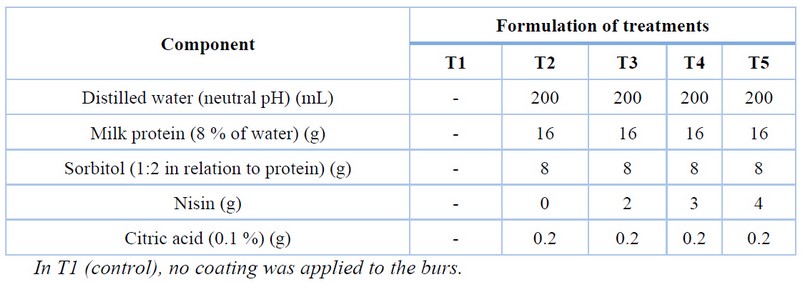
Table 2. Formulation established for each treatment. Bromatology Laboratory, Universidad Técnica Estatal de Quevedo, Quevedo, Ecuador. September 2022.
Application of the edible coating to F. ananassa
Strawberries were taken at random, observing that they were in optimal conditions, i.e., that they did not have any mechanical damage or fungal infections; the edible coating was applied utilizing the immersion process for 60 s for the elimination of the excess coating a small flow of hot air was used, and then they were stored at room temperature (24 ± 3 °C).
Physicochemical characterization
For the determination of °Brix performed according to "NTE INEN 2172:2014"16. Fruit juice - determination of soluble solids content - pycnometric method" using a J&G SC portable refractometer, where a drop of the peeled and liquefied sample was placed. The pH was measured according to "NTE INEN 1842:2013"17. Extract vegetable and fruit products" by direct reading in a digital pH meter pH/mV/T with table-top AT 700 series. The titratable acidity parameter was determined according to "NTE INEN 750:2013"18—vegetable and fruit products, considering that the predominant acid in the sample is citric acid. At the same time, the maturity index was performed according to the methodology of Solórzano et al. (2015), where they divided the °Brix content by the titratable acidity19.
Sensory characterization (five-point hedonic test).
For the sensory analysis, a panel of untrained randomized judges (students from the Universidad Laica Eloy Alfaro de Manabí, Manta, Ecuador) was organized, using the ordered preference test to evaluate acceptability and select the treatment with the best characteristics according to the categories evaluated. After the tasting, the panel was asked how much they liked or disliked each treatment. Where 1 = I would not say I like it very much, and 5 = I like it very much, it is emphasized that the control (uncoated treatment) was compared with the treatments that obtained the longest days of preservation.
Kruskal Wallis test
Once the sensory analysis results were obtained, the Kruskal Wallis test was applied for non-parametric data, which is based on the range that can be used to corroborate whether there is a significant difference between homogeneous groups20.
RESULTS
Physicochemical characterization
The increase in the °Brix concentration (Figure 1). of the strawberries preserved with the edible coatings during storage (5 days) allowed determining that T1 (uncoated strawberries) the storage time was 2 days at room temperature (24 ± 3 °C), which limited the sampling for the analysis of the variables, in the case of T1. In contrast, the other treatments showed a progressive increase in °Brix. It is also emphasized that, by using different concentrations of Nisin, it was possible to prolong the shelf life of the strawberries. Thus, the highest concentration for °Brix was determined for T5 with 8.70, while T3 obtained 7.67, both results on day 5 of storage. On the other hand, it is mentioned that T2 and T4 obtained a shorter storage time of 3 and 4 days, respectively, with 8.03 and 8.10 for the parameter in question.
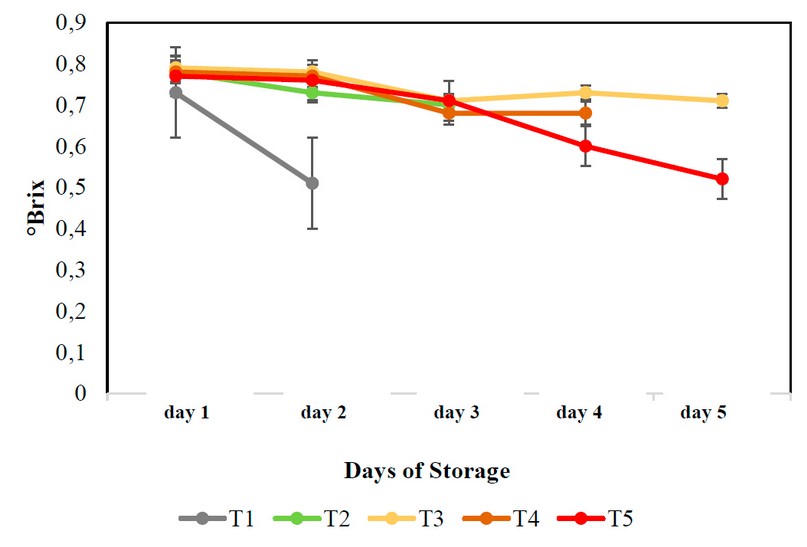
Figure 1. Multivariable analysis for the concentration of °Brix (p<0.05) of the treatments concerning the days of storage. Chemistry Laboratory of the Universidad Técnica Estatal de Quevedo, Quevedo, Ecuador. November 2022.
Regarding the pH results (Figure 2), it was observed that there was a significant difference (p<0.05), showing that the pH increases as the days of storage elapse; it is also emphasized that the uncoated strawberries (T1) had a shelf life of 2 days. On the other hand, treatments T2 and T4 presented values ranging from 6.40 - 6.50 for day 1, while at the end of their organoleptic maturity stage (day 3 and 4), they had ranges of 8.03 - 8.10, respectively, contrary to this, treatments T3 and T5 prolonged storage (day 5), with a pH of 7.67 and 8.70.
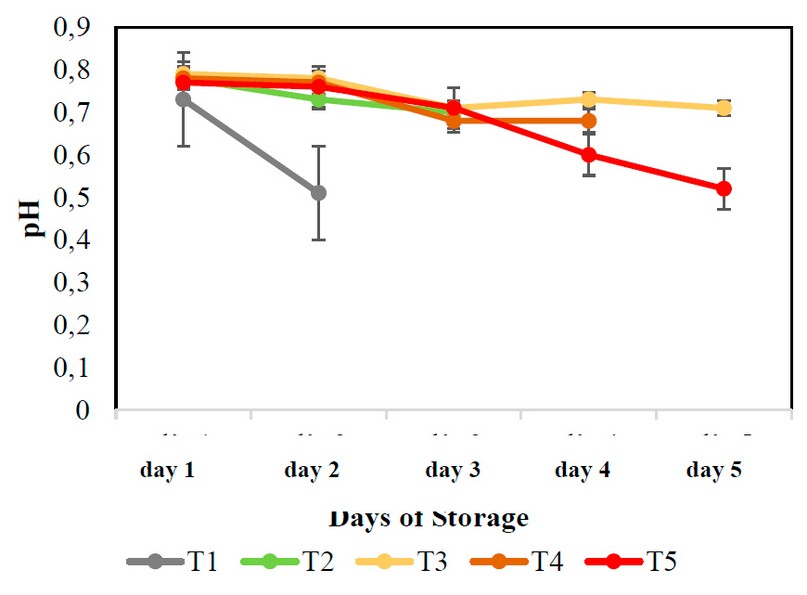
Figure 2. Multivariable analysis for pH (p<0.05) of the treatments concerning the days of storage. Chemistry Laboratory of the Universidad Técnica Estatal de Quevedo, Quevedo, Ecuador. November 2022.
For the results of titratable acidity (Figure 3), a prolonged decrease was observed during the days of evaluation, presenting statistically significant differences (p<0.05) concerning the uncoated strawberries (T1) with values of 0.73 - 0.51 (day 1 and 2), On the other hand, treatments T2 and T4 had values that fluctuated between 0.78 - 0.70 (day 1 and day 3) and 0.78 - 0.68 (day 1 and day 4) respectively, in contrast to treatments 3 and 5, which showed a longer storage time with mean values that ranged between 0.57 and 0.52.
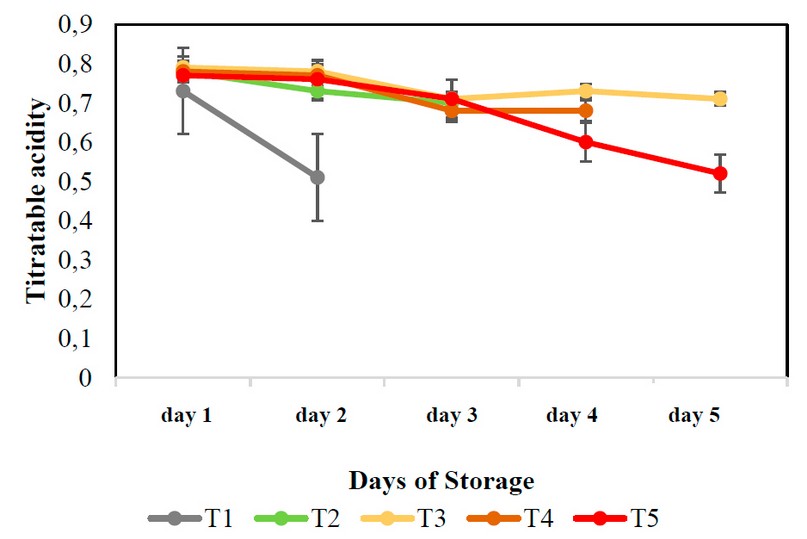
Figure 3. Multivariable analysis for the titratable acidity (p<0.05) of the treatments concerning the days of storage. Chemistry Laboratory of the Universidad Técnica Estatal de Quevedo, Quevedo, Ecuador. November 2022.
Regarding the maturity index (Figure 4), there was a significant difference (p<0.05), where it was shown that T1 presented an increase from 9.43 (day 1) to 18.70 (day 2). However, the other treatments, in which the coating with added Nisin was applied, showed a less accelerated behavior. It is worth mentioning that T2 and T4 evidenced a similar increase with values of 11.50 and 11.83 until reaching their senescence stage (day 3 and day 4, respectively). At the same time, T3 and T5 obtained a longer shelf life, reaching a maturity index of 15.94 and 16.74.
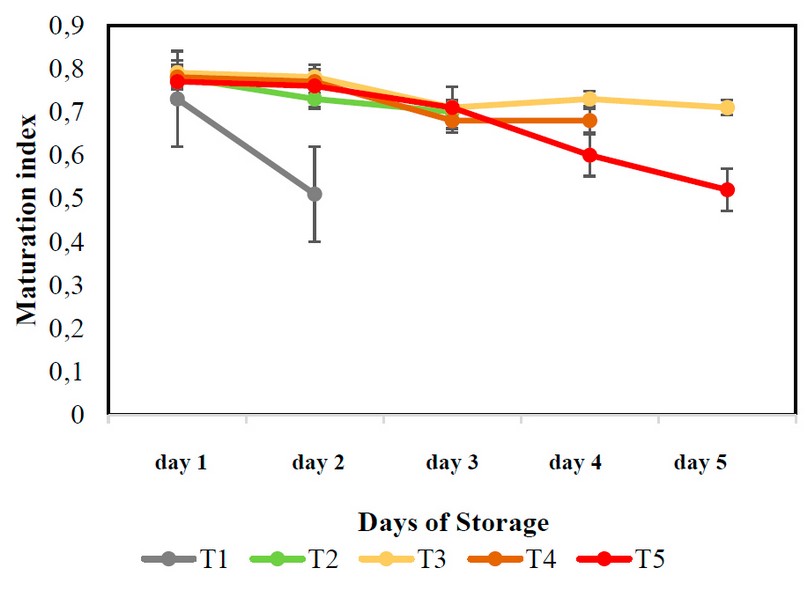
Figure 4. Multivariable analysis for the maturity index (p<0.05) of the treatments concerning the days of storage. Chemistry Laboratory of the Universidad Técnica Estatal de Quevedo, Quevedo, Ecuador. November 2022.
Sensory characterization
For the sensory categories (color, aroma, flavor and acceptability), the level of preference and acceptance of treatments T1, T3 and T5 was determined, considering that T3 and T5 presented longer storage time of the strawberries (Table 3).
The results of the Kruskal Wallis test for the sensory parameter color presented a P-value of 0.1006, which showed no significant difference between the treatments evaluated. In addition, it was identified that the highest valuation, 4.00 ± 0.80, was located in T3, placing it according to the score of the hedonic scale with the category "I like it". In contrast, T1 and T5 placed lower values with 3.40 ± 0.72 and 3.20 ± 1.10, respectively; the treatments presented a red and intense red.
A significant difference was found for aroma with a P-value of 0.4107, where it was observed that the uncoated treatment (T1) obtained a higher score on the scale with 2.93 ± 1.23 compared to T5, which had the lowest score with 2.47 ± 0.98. It is worth mentioning that the tasters described the aroma of the fruit as slightly perceptible to moderately intense.
Concerning the results for the flavor parameter, it can be observed that there was no significant difference between treatments, with a P-value of 0.7299. However, the Tukey multiple range test shows that T1 has a higher valuation for this sensory attribute with a mean of 4, 67 ± 1.31, followed by T3 with 4.60 ± 1.25 corresponding to the category "I like it" in contrast to T5, which obtained a lower valuation of 2.75 ± 0.86, placing itself according to the hedonic scale score with the category "Neither like nor dislike."
The level of acceptance of the treatments (Table 3) was not significant since a P-value of 0.6133 was obtained; however, using the multiple range test, it was identified that T1 presented the highest rating with a mean of 3.67 ± 1.25, followed by T3, which presented a rating of 3.62 ± 1.33. At the same time, T5 had the lowest rating, with 2.75 ± 1.63, being less pleasant to the tasters.
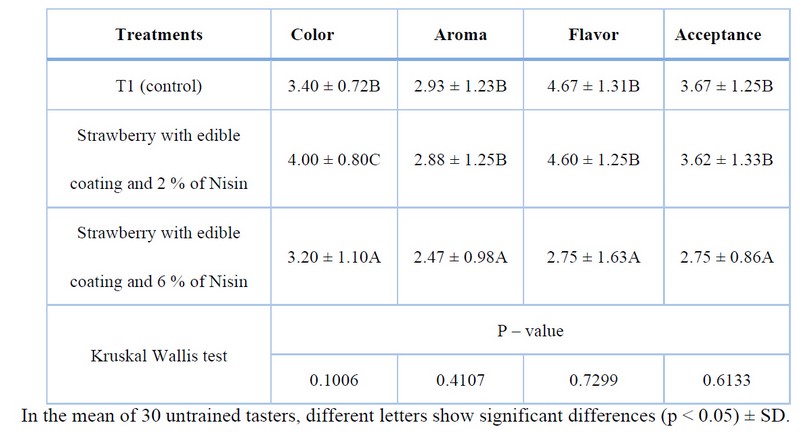
Table 3. Sensory characterization of treatments with longer shelf life than control treatment (uncoated strawberries). Universidad Laica Eloy Alfaro de Manabí, Manta, Ecuador. December 2022.
DISCUSSION
Coated strawberries showed an increase in °Brix content. However, their conservation was higher compared to the control. This increase is related to the fruit's starch and the coating composition, converted into simple sugar21. The °Brix represents the state of maturity of a fruit, i.e., the higher the °Brix content, the higher the degree of maturity, and for an acceptable flavor, a minimum of 7% soluble solids (°Brix) is recommended22. Applying edible coatings to rapidly degrading fruits slows the increase in °Brix compared to the control7.
The increase in pH is due to the consumption of organic acids during ripening and fruit senescence processes. It is also due to the binding of free pectic fragments in the cell wall with polyphenols during ripening processes. In addition, research on using edible coatings based on Tuna Agria mucilage determined pH values between 3.60 and 3.9824. On the other hand, when using a bioactive coating based on vegetable gelatin, sugar starch and cinnamon essential oil, the pH ranged from 5.50 to 6.7825.
The reduction of acidity is associated with fruit ripening. This can be verified by the values obtained in this study, which presented a behavior similar to those reported in blackberries treated with aloe vera and received acidity values of 1.16 to 0.9 g citric acid/100 g, as well as in blackberries coated with cinnamon oil and strawberries covered with penca mucilage 26. It is essential to mention that the maximum decrease can be 0.50, and this tendency is correlated with the increase in pH 27.
The values for the maturity index increased with the passage of days; the coating slows down the ripening process of the coated samples, which is a great advantage because it extends the shelf life of the fruit28. The results obtained in this research presented a similar behavior to those registered in "Rio Red" grapefruits waxed with commercial wax with 14 % of solids and methyl jasmonate 10-3 M in dissolved form presented a maturity index between 10.43 and 32.2529. Although the maturity index is not the only factor that determines if the strawberry has reached the end of its useful life, it is a significant value to establish a limit parameter to consider when evaluating the useful life of the fruit30.
Coatings with a 2% concentration of Nisin are sensorially acceptable since they do not modify the original color of the fruit. On the other hand, some researchers determined that strawberries coated with propolis and soy protein allowed maintaining the red coloration in the coated fruits during the evaluation period and preserving the color in an effective way31. Also, the coating based on aloe vera, ethanolic extract of propolis and essential oil of orange had an effect in intensifying the brightness of tomatoes32.
Coatings do not significantly influence the aroma of strawberries; according to research on coatings composed of whey protein isolate and concentrate in the hydrophilic phase and beeswax (BW) in the lipid phase, they do not affect the aroma of freshly cut coated fruits, being sensorially acceptable, i.e., they do not impart strange flavors or odors33. It is worth mentioning that there are also highly impermeable coatings that induce the creation of anaerobic conditions, causing, as a consequence, a loss of the typical aromatic compounds of the fruit and the presence of undesirable aromas. Therefore, it is essential to know the nature of the ingredients of the film or coating32.
Fruit ripening involves complex processes that cause significant changes in their sensory properties, such as flavor and texture, which directly influence the final product quality 33. On the other hand, when using tara gum in the postharvest quality of strawberries, there were no changes in the flavor, where the panelists mentioned that it does not confer any residual flavor; in this way, they were able to delay the senescence of the coated strawberries21.
Using 2% nisin in the coatings made it possible to obtain strawberries with an acceptable quality level similar to the uncoated strawberries; the coatings represent an effective alternative against quality damage, improving the shelf life during storage. Studies on the application of edible coatings showed that the general sensory acceptance for coated samples was higher than 70%, demonstrating that coatings could be applied without generating rejection problems in consumers 33. On the other hand, it is mentioned that the use of edible coatings on products submitted to osmotic dehydration presented favorable results in the level of acceptance of the samples34.
CONCLUSIONS
Applying an edible coating based on milk protein and Nisin (2% and 6%) positively affected preserving physicochemical characteristics such as °Brix, pH, titratable acidity and maturity index. In addition, the addition of 2 % nisin had a significant influence on sensory traits: color, aroma, flavor and acceptability, presenting similar intensities to the treatment without coating, thus concluding that it can be used as an effective alternative during postharvest handling of strawberries and also contributing to the food industry with the development of a new packaging and protection technology for fruits, to replace conventional plastic and promote sustainable and sustainable development.
Finally, another trend in the development of new coatings is the incorporation of healthy additives, including probiotics with the introduction of vitamins and minerals in fruits with a tendency to more significant degradation, such as blackberry, raspberry, papaya, and mango, among others.
Author contributions: "Conceptualization, GGA and VGT; methodology, KRE; software, KRE; research, TOC; writing-preparation of the original draft, JAM All authors have read and accepted the published version of the manuscript".
Funding: The present research is funded by the Universidad Técnica Estatal de Quevedo.
Conflicts of interest: "The authors declare that they have no conflicts of interest".
REFERENCES
1. FAO. The Future of food and agriculture. Trends and challenges. Food and Agriculture Organization of the United Nations. 2017. .https://www.fao.org/3/i6881s/i6881s.pdf
2. Martínez-González, M. E., Balois Morales, R., Alia-Tejacal, I., Cortes-Cruz, M. A., Palomino-Hermosillo, Y. A., & López-Gúzman, G. G. Postharvest of fruits: ripening and biochemical changes. Mexican Journal of Agricultural Sciences. 2017; 19(67), 4075-4087. https://doi.org/10.29312/remexca.v0i19.674.
3. Valencia-Chamorro, S., & Torres-Morales, J. Edible coatings applied on IV and V gamma products. Revista iberoamericana de poscosecha. 2016; 17(2), 162-174. https://www.redalyc.org/journal/813/81349041004/html/
4. Miteluț, A. C., Popa, E. E., Drăghici, M. C., Popescu, P. A., Popa, V. I., Bujor, O.-C., Ion, V. A., & Popa, M. E. Latest developments in edible coatings on minimally processed fruits and vegetables: A review. Foods. 2021; 10(11), 2821. https://doi.org/10.3390/foods1011282
5. Rodríguez-Villacres, A. J. Development of an edible coating based on cocoa mucilage with the addition of essential oils (coconut, oregano and olive) for the preservation of apples cocoa mucilage with addition of essential oils (coconut, oregano and olive) for the preservation of apples conservation of apples (Royal gala) [Thesis, Universidad Agraria del Ecuador]. Institutional Repository of the Universidad Agraria del Ecuador. 2021; https://cia.uagraria.edu.ec/Archivos/RODRIGUEZ%20VILLACRES%20JOHNNY%20ABRAHAM.pdf
6. Marelli, B., Brenckle, M. A., Kaplan, D. L., & Omenetto, F. G. Silk fibroin as edible coating for perishable food preservation. Scientific Reports. 2016; 6(25263). https://doi.org/10.1038/srep25263
7. Ferrer- Morocho, V. Y. Effect of the application of an edible coating based on starch from starch-based edible coating of cidrayota (Sechium edule) of the virens levisenla variety quality and shelf life of strawberries (Fragaria ananassa) [Thesis, Universidad Técnica de Ambato]. Institutional Repository of the Universidad Técnica de Ambato. 2020; https://repositorio.uta.edu.ec/handle/123456789/31413
8. Ulusoy, B. H., Yildirim, F. K., & Hecer, C. Edible films and coatings: A good idea from past to future technology. Journal of Food Technology Research. 2018; 5(1), 28- 33. https://doi.org/10.18488/journal.58.2018.51.28.33
9. Pratap-Singh D, Packirisamy G. Biopolymer based edible coating for enhancing the shelf life of horticulture products. Food Chemistry: Molecular Sciences. 2022; 4. https://doi.org/10.1016/j.fochms.2022.100085.
10. Trela, V. D. Preservation of tropical fruits (Quinoto, Blackberry and Carambola) applying edible coatings [Doctoral thesis, Universidad Nacional de Misiones]. Institutional Repository of the Universidad Nacional de Misiones, 2018; https://repositorioslatinoamericanos.uchile.cl/handle/2250/5172719
11. Hassan, B., Chatha, S. A., Hussain, A. I., Zia, K. M., & Akhtar, N. Recent advances on polysaccharides, lipids and protein based edible films and coatings: A review. International Journal of Biological Macromolecules. 2018; 109, 1095-1107. https://doi.org/10.1016/j.ijbiomac.2017.11.097
12. Fernández-Valdés D, Bautista Baños S, Fernández-Valdés D, Ocampo-Ramírez A, García - Pereira A, Falcón-Rodríguez A. Edible films and coatings: a favorable alternative in postharvest preservation of fruits and vegetables. Revista Ciencias Técnicas Agropecuarias, 2015; 24(3). 52-57. https://rcta.unah.edu.cu/index.php/rcta/article/view/405/414
13. Ramos-García ML, Romero-Bastida C, Bautista-Baños S. Modified starch: Properties and uses as edible coatings for the preservation of fresh fruits and vegetables. Iberoamerican journal of postharvest technology. 2018; 19(1). https://www.redalyc.org/journal/813/81355612003/813543612003.pdf
14. Castellano-Gastelo, L. Á & Neciosup-Burga, S. I. Formulation of an edible film and coating from the utilization of bovine whey in the lambayeque region [Undergraduate thesis, Universidad Nacional "Pedro Ruiz Gallo"]. Institutional Repository of the Universidad Nacional "Pedro Ruiz Gallo; 2016. https://repositorio.unprg.edu.pe/handle/20.500.12893/864.
15. INEN-ISO. Fruit juice - determination of soluble solids content - pycnometric method; Instituto Ecuatoriano de Normalización. 2172: 2013. https://www.normalizacion.gob.ec/buzon/normas/nte_inen_iso_750_extracto.pdf4
16. INEN. Excerpt. Vegetable and fruit products pH determination (IDT); Instituto Ecuatoriano de Normalizacion.1842:2013. https://www.normalizacion.gob.ec/buzon/normas/nte_inen_iso_750_extracto.p
17. Solórzano AC, Martín A, Salazar SM, Sandoval1 JS, Kirschbaum DS. Correlation between fruit color measurement and total soluble solids concentration in strawberry (Fragaria ananassa Duch.). Agronomic journal of northwestern Argentina. 2015; 35(1), 55-60. http://www.scielo.org.ar/scielo.php?script=sci_arttext&pid=S2314- 369X2015000100008
18. Quispe-Andía, A., Calla-Vasquez, K., Yangali-Vicente, J., Rodríguez-López, J., & Pumacayo-Palomino, L. Non-parametric statistics applied to scientific research with SPSS, MINITAB AND EXCEL software (1st ed.). Editorial Eidec. 2019. https://www.editorialeidec.com/wpcontent/uploads/2020/01/Estad%C3%ADstica-no-param%C3%A9trica-aplicada.pdf.
19. Ruiz-Medina M, Ávila J, Ruales J. Design of a bioactive edible coating to be applied to strawberries (fragaria vesca) as a postharvest process. Iberoamerican Magazine of Postharvest Technology. 2016; 17(2): 276-287. https://www.redalyc.org/journal/813/81349041015/html
20. Contigiani EV. Development of alternative strategies for postharvest conservation of strawberries [PhD thesis, Universidad de Buenos Aires]. Institutional Repository of the Universidad de Buenos Aires. 2016. https://bibliotecadigital.exactas.uba.ar/download/tesis/tesis_n6634_Contigiani.pdf
21. Mendoza-González S, Vázquez-Briones M, Aguilar-Raymundo V. Edible coatings based on Sour Prickly Pear mucilage (Opuntia joconostle) applied on Strawberries (Fragaria x ananassa cv. Festival) and their effect on physicochemical and sensory properties. Iberoamerican Magazine of Postharvest Technology. 2020; 2-11. https://www.redalyc.org/articulo.oa?id=81363356007
22. De Bruno A, Gattuso A, Ritorto D, Piscopo A, Poiana M. Effect of Edible Coating Enriched with Natural Antioxidant Extract and Bergamot Essential Oil on the Shelf Life of Strawberries. Foods. 2023; 12(3): 488. https://doi.org/10.3390/foods12030488
23. Odetayo T, Tesfay S, Ziphorah- Ngobese N. Nanotechnology-enhanced edible coating application on climacteric fruits. Food Science & Nutrition. 2022. 10(7), 2149– 2167. https://doi.org/10.1002/fsn3.2557
24. Salehi F. Edible Coating of Fruits and Vegetables Using Natural Gums: A Review. International Journal of Fruit Science. 2020; 20(2), 570-589. https://doi.org/10.1080/15538362.2020.1746730
25. Aroca K, Regalado O, Acosta S. Study of fruit preservation in "iv gama" with the application of a biodegradable-active coating. Ecuador es Calidad: Revista Científica Ecuatoriana,. 2018; 5(1). https://doi.org/10.36331/revista.v5i1.38
26. Handojo L, Shofinita D, Evelina G, Nasution A. Development of edible coating to extend shelf life of mangoes (Mangivera indica L.). [Conference report]. 4th International Conference on Food and Agriculture (ICOFA 2022). IOP Lecture Series. Earth and Environmental Sciences, (2022, November 6-7). 980(1), 6-7. https://doi.org/10.1088/1755-1315/980/1/012046
27. Villegas C, Albarracín, W. Application and effect of an edible coating on the shelf life of blackberry (Rubus glaucus benth). Vitae Journal. 2016; 23(3), 202-209. https://doi.org/10.17533/udea.vitae.v23n3a09
28. Fernández NM, Echeverria DC, Mosquera SÁ, Paz S. Current status of the use of edible coatings on fruits and vegetables. Biotechnology in the Agricultural and Agroindustrial Sector. 2017; 15(2), 134-141. https://doi.org/10.18684/bsaa(15)134-141.
29. Rosero A, Espinoza-Montero P, Fernandez L. Edible coatings with micro/nano-structured materials for fruit and vegetable preservation: a review. InfoAnalítica.2020; 8(1), 149-178. https://doi.org/10.26807/ia.vi.180
30. Pham TT, Nguyen LP, Dam MS, Baranyai L. Application of edible coating in extension of fruit shelf life: Review. AgriEngineering. 2023; 5(1), 520–536. https://doi.org/10.3390/agriengineering5010034
31. Alvarado-Cepeda Y, Mendoza-Villarreal R, Sandoval-Rangel A, Vega-Chávez J, Franco-Gaytán I. Physicochemical and sensory quality of strawberry fruits obtained in two cultivation systems. International Journal of Research and Technological Innovation. 2020; 8(43), 18-29. https://www.scielo.org.mx/scielo.php?pid=S2007-97532020000200002&script=sci_abstract&tlng=en
32. Pavón-Vargas D, Valencia-Chamorro S. Effect of edible tara gum-based composite coatings on postharvest quality of strawberry (Fragaria ananassa). Iberoamerican Journal of Postharvest Technology. 2016, 17(1), 65-70. https://www.redalyc.org/articulo.oa?id=81346341009
33. Stan A, Bujor O, Dobrin A, Haida G, Bădulescu L, Asănică A. Monitoring the quality parameters for organic raspberries in order to determine the optimal storage method by packaging. Acta Horticulturae. 2020; 1277, 461-468. https://doi.org/10.17660/actahortic.2020.1277.66
34. Soteras EM. Application of edible coatings to products subjected to osmotic dehydration [Doctoral thesis, Universidad Nacional de la Plata]. Repositorio Institucional de la Universidad Nacional de la Plata; 2019. http://sedici.unlp.edu.ar/bitstream/handle/10915/109773/Documento_completo.p df-PDFA.pdf?sequence=1&isAllowed=y
Received: 25 June 2023/ Accepted: 26 August 2023 / Published:15 September 2023
Citation: Guapi Álava G, Guerrón Troya V, Oña Cundulle T, Revilla Escobar K, Aldas Morejon J, Caicedo Álvarez E. Effect of milk protein coating and Nisin on the postharvest quality of strawberries (Fragaria ananassa).. Revis Bionatura 2023;8 (3) 49. http://dx.doi.org/10.21931/RB/2023.08.03.49
